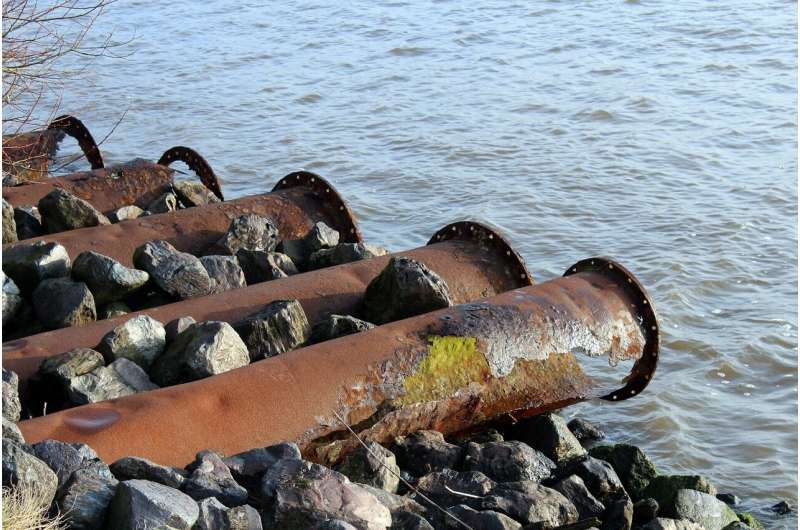

Researchers at Oxford Brookes University have pioneered an innovative method to tackle one of the world’s most persistent environmental threats—toxic chemicals in global water supplies.
They have developed a new machine called a hydrodynamic reactor that uses bubbles which form and collapse due to changes in pressure, a process called cavitation. The reactor removes toxic per- and poly-fluoroalkyl substances (PFAS), also known as “forever chemicals” from water. The paper is published in the Chemical Engineering Journal.
PFAS chemicals were invented in the 1930s and used in convenience products like waterproof clothing, pizza boxes, nonstick pans, and stain-resistant carpets. Concerns were raised about these chemicals being toxic in the 1970s and confirmed by scientists in the early 2000s. They have been found to be a health hazard that has infiltrated water supplies worldwide. The chemicals are associated with diseases such as ulcerative colitis, thyroid problems, elevated cholesterol, liver damage, and cancer.
Removing PFAS chemicals from water sources is a global challenge. They are released into water sources through industry wastewater, landfills containing contaminated products, domestic wastewater, sewage and agricultural run-off.
Professor Iakovos Tzanakis, who specializes in Engineering Materials at Oxford Brookes and is one of the lead researchers, said, “Once contaminated water is released into rivers, lakes and seas, it eventually infiltrates our public water supplies, including our domestic drinking water. Our challenge has been to find a way of effectively treating water to remove PFAS chemicals sustainably and at a scale.”
In the UK the Royal Society of Chemists has launched a campaign to reduce the levels of PFAS in our water supplies. The EU is planning to restrict the use of PFAS chemicals with new rules introduced in 2024. In America, legally enforceable PFAS levels have also been established to protect public safety.
Professor Tzanakis said, “Until now, methods of removing PFAS from water have been costly and time-consuming using chemicals and restricted to laboratory scale. But research I have carried out with my colleague Dr. Morteza Ghorbani has identified a potential solution.”
Professor Tzanakis and Dr. Ghorbani, a Royal Society-Newton Fellow at Oxford Brookes, collaborated with Sabanci University (Turkey), white goods manufacturer Beko (Turkey), KTH Royal Institute of Technology (Sweden), and IVL Swedish Environmental Research Institute to develop and test the hydrodynamic cavitation reactor.
The reactor uses fast-moving liquid in tiny spaces to create and pop lots of small bubbles—a process that helps to clean the water.
Professor Tzanakis said, “This technology has the potential to revolutionize wastewater treatment, making it safer and more sustainable for communities around the globe. The advancements in green hydrodynamic cavitation provide a scalable alternative to current methods, overcoming its limitations.”
When the eco-friendly and energy-efficient hydrodynamic cavitation reactor was tested at the Hammarby Sjöstad wastewater treatment plant in Sweden, the results were far better than expected.
The reactor achieved nearly a 36% degradation rate of 11 common PFAS variants in just 30 minutes and didn’t need additional chemicals.
Dr. Ghorbani, who is also affiliated to Sabanci University, said, “The results were impressive. We didn’t expect that level of PFAS processing in such a short space of time. We are now exploring the fundamental mechanisms of PFAS removal in depth at Oxford Brookes University to better control and optimize the process.
“Our next step is scaling up our reactor to treat larger volumes of wastewater containing PFAS. We are aiming to treat wastewater containing PFAS volumes up to 20 liters. The reactor for this has already been built. After that, our target is to treat volumes up to 200 liters in a wastewater treatment plant in Sweden.
“Our goal is to boost this promising approach by unveiling the intricate physics that drive the technology through the use of various reactors in different countries. We want to ensure this technology is ready for actual wastewater treatment in the near future and as set by EU 2035 strategy when all PFAS-containing waste must be treated.”
More information:
Farzad Rokhsar Talabazar et al, Removal of per- and polyfluoroalkyl substances (PFAS) from wastewater using the hydrodynamic cavitation on a chip concept, Chemical Engineering Journal (2024). DOI: 10.1016/j.cej.2024.153573
Provided by
Oxford Brookes University
Citation:
Innovative method targets removal of PFAS from wastewater (2024, October 4)
retrieved 4 October 2024
from https://phys.org/news/2024-10-method-pfas-wastewater.html
This document is subject to copyright. Apart from any fair dealing for the purpose of private study or research, no
part may be reproduced without the written permission. The content is provided for information purposes only.